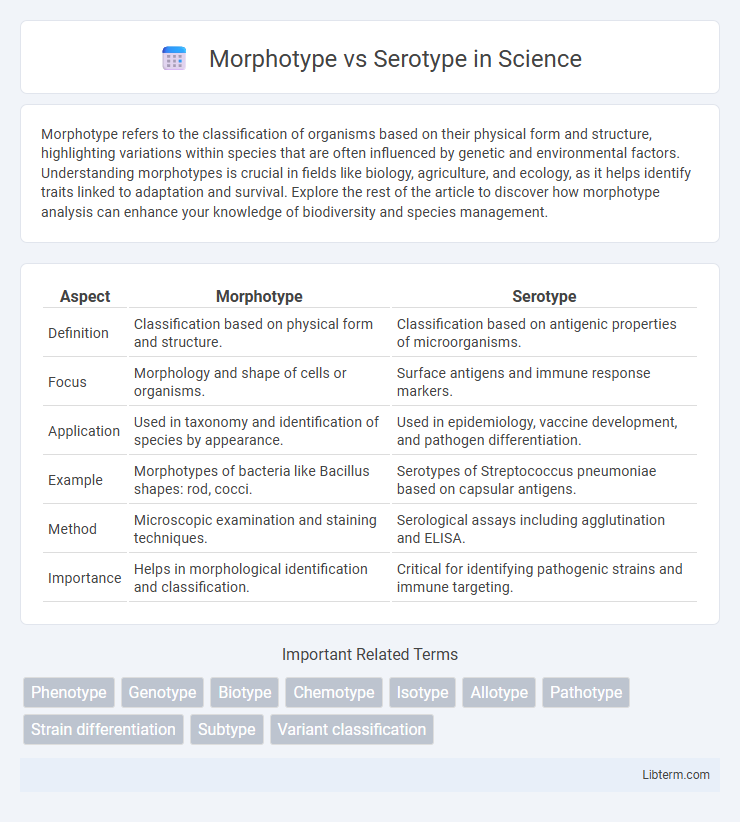Morphotype refers to the classification of organisms based on their physical form and structure, highlighting variations within species that are often influenced by genetic and environmental factors. Understanding morphotypes is crucial in fields like biology, agriculture, and ecology, as it helps identify traits linked to adaptation and survival. Explore the rest of the article to discover how morphotype analysis can enhance your knowledge of biodiversity and species management.
Table of Comparison
| Aspect | Morphotype | Serotype |
|---|---|---|
| Definition | Classification based on physical form and structure. | Classification based on antigenic properties of microorganisms. |
| Focus | Morphology and shape of cells or organisms. | Surface antigens and immune response markers. |
| Application | Used in taxonomy and identification of species by appearance. | Used in epidemiology, vaccine development, and pathogen differentiation. |
| Example | Morphotypes of bacteria like Bacillus shapes: rod, cocci. | Serotypes of Streptococcus pneumoniae based on capsular antigens. |
| Method | Microscopic examination and staining techniques. | Serological assays including agglutination and ELISA. |
| Importance | Helps in morphological identification and classification. | Critical for identifying pathogenic strains and immune targeting. |
Introduction to Morphotype and Serotype
Morphotype refers to the classification of organisms based on their physical appearance and structural features, providing insight into phenotypic variations within species. Serotype is a distinct classification based on antigenic properties of microorganisms, particularly the variations in surface proteins and polysaccharides that trigger immune responses. Understanding morphotypes aids in studying morphological diversity, while serotypes are critical for identifying pathogens and developing targeted vaccines.
Defining Morphotype: Key Characteristics
Morphotype defines bacterial classification based on observable physical and structural characteristics, including cell shape, size, and colony appearance on growth media. It emphasizes phenotypic traits such as pigmentation, texture, and cellular arrangements, which are crucial for identifying variations within species. Morphotyping aids in understanding bacterial adaptation and ecological roles, complementing genetic and serological analyses.
Understanding Serotype: An Overview
Serotype classification identifies microorganisms based on distinct surface antigens, enabling precise differentiation within species such as bacteria and viruses. This method is crucial for tracking epidemiological patterns, vaccine development, and diagnosing infectious diseases by recognizing specific immune responses. Unlike morphotypes, which rely on structural and phenotypic traits, serotypes focus on antigenic properties, providing a more targeted approach for clinical and microbiological analysis.
Major Differences Between Morphotype and Serotype
Morphotype refers to the classification of organisms based on observable structural characteristics and physical appearance, while serotype categorizes microorganisms according to their distinct antigenic properties detected by immune responses. Morphotyping focuses on phenotypic traits such as shape, size, and colony morphology, whereas serotyping relies on identifying specific surface antigens, particularly in bacteria and viruses. These fundamental differences impact diagnostic methods, with morphotyping using microscopy and culture techniques and serotyping employing immunological assays like agglutination or ELISA.
Importance in Microbial Identification
Morphotype classification relies on observable physical characteristics such as shape and colony morphology, providing rapid preliminary identification of microbial species. Serotype differentiation uses specific antigenic properties of cell surface molecules, enabling precise identification and epidemiological tracking of bacterial strains. Combining morphotype and serotype analyses enhances the accuracy and specificity of microbial identification in clinical and environmental microbiology.
Methods of Determining Morphotype
Morphotype determination relies on visual and microscopic examination of colony morphology, cellular shape, and staining characteristics, often using light microscopy and differential staining techniques such as Gram staining. Advanced methods include 3D imaging and electron microscopy to analyze surface structures and cell appendages in detail, enhancing the morphological differentiation. Standardized culture conditions and media are essential for reproducible morphotype identification, as environmental factors can significantly influence the phenotypic expression.
Techniques for Serotype Classification
Serotype classification primarily relies on immunological techniques such as slide agglutination and enzyme-linked immunosorbent assays (ELISA), which detect specific surface antigens on bacteria or viruses. Molecular methods like PCR and whole-genome sequencing have enhanced serotyping accuracy by identifying genetic markers linked to serotype differences. These techniques enable precise differentiation among serotypes, facilitating epidemiological tracking and vaccine development.
Applications in Medical Microbiology
Morphotype and serotype characterization play crucial roles in medical microbiology by aiding in the identification and classification of pathogenic microorganisms. Morphotyping relies on observable physical traits such as colony shape, size, and color, enabling rapid preliminary screening of bacterial strains during infection outbreaks. Serotyping focuses on detecting specific surface antigens using antibody-based tests, providing precise differentiation critical for vaccine development, epidemiological tracking, and guiding targeted antimicrobial therapy.
Challenges in Morphotype and Serotype Analysis
Morphotype analysis faces challenges due to phenotypic variability influenced by environmental factors, making it difficult to achieve consistent classification. Serotype analysis encounters complexity from cross-reactivity and overlapping antigenic profiles, complicating accurate identification. Both methods require advanced protocols and standardized reagents to improve specificity and reproducibility in microbial typing.
Future Directions in Typing Strategies
Future directions in typing strategies emphasize integrating genomic sequencing with traditional morphotype and serotype methods to enhance pathogen identification accuracy and resolution. Advances in bioinformatics facilitate comprehensive analysis of genetic variation, enabling the development of personalized treatment plans and epidemiological tracking. Continued innovation in rapid, high-throughput sequencing technologies promises to streamline diagnostic workflows, supporting real-time surveillance and outbreak control.
Morphotype Infographic

 libterm.com
libterm.com